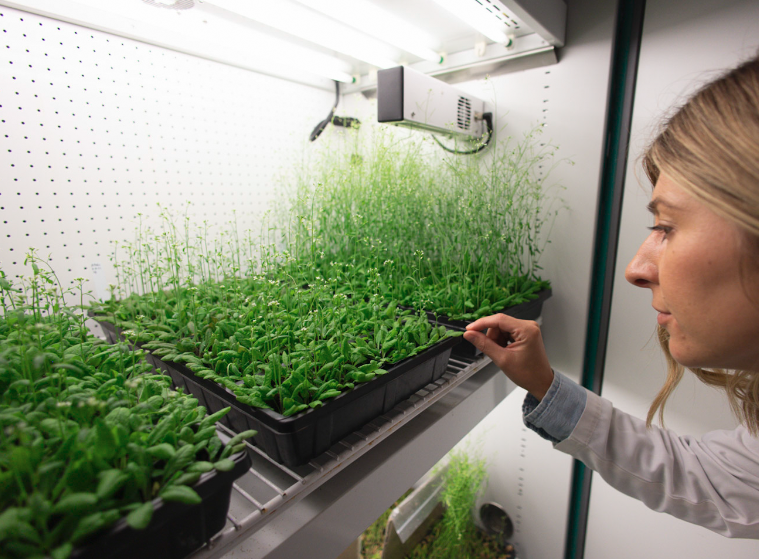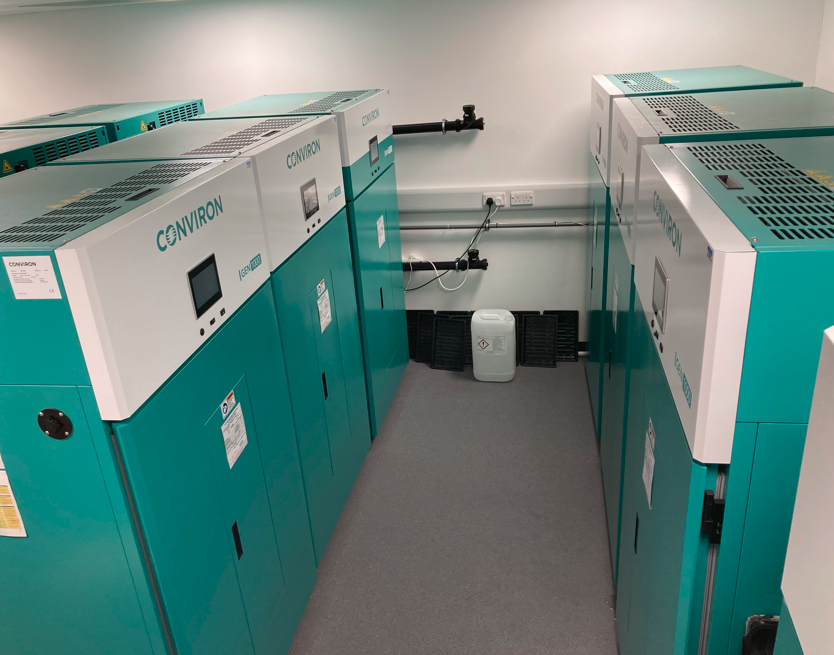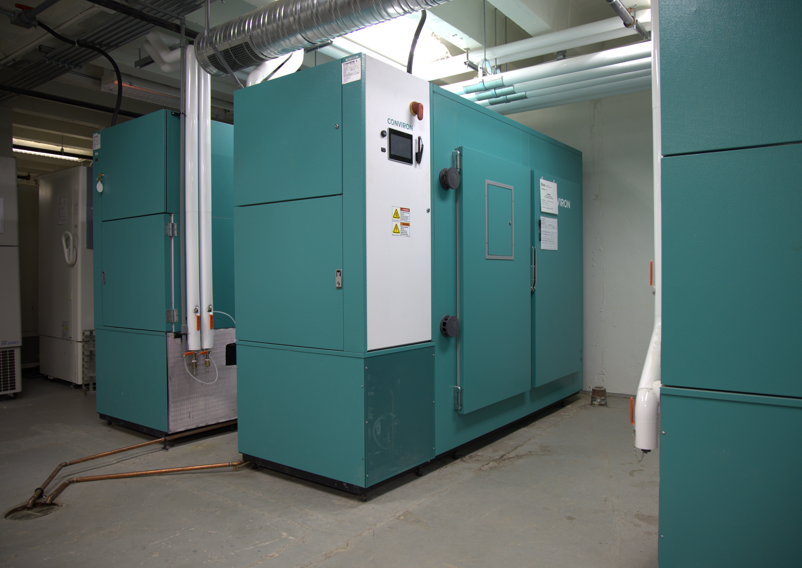What is a plant growth chamber?
Mar 8, 2024
Understanding the precise conditions under which plants can grow and thrive is fundamental to addressing some of our most pressing global challenges, including food security and the need for more sustainable agriculture. Plant growth chambers play a pivotal role in this endeavor.
Plant growth chambers enable scientists to create precisely-controlled environments that mimic a wide range of climatic conditions, advancing research in areas such as plant biology, genetics, and agricultural sciences.
This guide will provide an overview of plant growth chambers, the factors they’re able to control, their types and applications, and how they’re helping to create a more sustainable world.

Quick Takeaways
- Plant growth chambers allow for tight control of environmental variables such as temperature, light, humidity, and CO2 levels to study plant growth
- They are crucial for researching the effects of genetic modifications on plants, ensuring changes are due to genetics, not environmental factors
- Plant growth chambers support vital research to enhance crop yields, develop stress-resistant varieties, and improve nutritional quality, addressing food security and sustainable agriculture
- They are also important to accelerate research timelines by fully controlling environmental variables, enabling quick crop turns and compressing growing cycles
- Types of plant growth chambers include reach-in, walk-in, and custom chambers, each serving specific research purposes
- Insights from studies conducted in plant growth chambers help advance research on issues of global importance such as sustainable agricultural practices and ensuring a stable food supply for the future
What is a Plant Growth Chamber?
Like all living things, plants require the right environment to grow and thrive. Sunlight, oxygen, carbon dioxide, water, and other nutrients all contribute to plant health, enabling them to perform the metabolic processes necessary for survival.
However, the environment accounts for only half of what influences plant growth. The rest is determined by the plant's genetic makeup. With advancements in plant science, researchers can now modify a single gene in a plant. To accurately assess how these genetic modifications impact plant growth, it's crucial to control the environmental variables meticulously.
Enter plant growth chambers.
Plant growth chambers create precise environmental conditions for plant research. These chambers allow scientists to isolate genetic effects by controlling factors such as temperature, humidity, light, and CO2 levels, ensuring that any observed changes in plant development are directly attributable to the genetic modifications, rather than external environmental fluctuations.

Let’s look at each of these factors in more detail:
Temperature
Temperature influences physiological processes such as germination, photosynthesis, respiration, and flowering. Plant growth chambers can precisely control temperature, allowing researchers to simulate different climatic conditions. This precision enables the study of plant responses to temperature stresses, such as heat or cold, and the determination of optimal growth temperatures for various plant species.
Light
Light is essential for photosynthesis, and the intensity, quality (wavelength), and duration (photoperiod) of light can significantly affect plant growth, morphology, and flowering cycles. Plant growth chambers are equipped with lighting systems that can mimic natural sunlight or provide specific light spectra, enabling scientists to investigate the effects of light on plant behavior and physiology under controlled conditions.
Humidity
Humidity impacts plant transpiration rates, hydration, and nutrient uptake. Maintaining appropriate humidity levels is crucial for preventing plant stress and diseases. Plant growth chambers allow for the regulation of humidity to specific levels, facilitating studies on how varying humidity conditions affect plant growth, development, and resistance to environmental stresses.
CO2 Levels
Carbon dioxide is a key substrate for photosynthesis, and its concentration in the environment can influence plant growth rates and biomass production. By controlling CO2 levels within plant growth chambers, researchers can study the effects of elevated or reduced CO2 concentrations on plant physiology, yield, and adaptation to climate change. This control is particularly important for research into how plants might respond to future atmospheric conditions and for optimizing conditions for maximum growth efficiency.
Plant Growth Chamber Types & Applications
There are various types of plant growth chambers, each designed to meet specific research needs and applications. They range from small, benchtop units to large, walk-in rooms, offering flexibility in size and functionality to accommodate different plant species and experimental setups.
Reach-in Plant Growth Chambers
Reach-in chambers are compact and versatile, making them suitable for laboratories with limited space. They are ideal for conducting smaller-scale experiments such as seed germination studies, plant pathology research, or genetic modification assessments.
Even at their smaller size, they offer precise control over environmental conditions, allowing researchers to replicate a wide range of climates and study their effects on plant growth and development.

Walk-in Plant Growth Chambers
Walk-in chambers provide increased room to accommodate research projects that require more growth space or involve larger plant specimens. They are commonly used in agricultural research to simulate field conditions, study crop responses to environmental stressors, and evaluate the efficacy of genetic modifications on a larger scale.
Walk-in chambers are essential for experiments that demand the cultivation of plants to maturity or the accommodation of tall species.
Custom Chambers & Rooms
Custom plant growth chambers and rooms are tailored to meet the unique requirements of specific research projects. They can be designed to offer unique environmental conditions not achievable with standard models, such as extreme temperatures, humidity levels, or specialized lighting systems.
They’re crucial for supporting advanced research into plant responses to unique environmental stresses, the development of crops for extreme climates, and the testing of novel agricultural technologies.
Creating a More Sustainable World
Plant growth chambers are vital to supporting research aimed at overcoming some of the most pressing challenges facing humanity today, including global food security and sustainable agricultural practices. The global population is expected to grow by 2 billion over the next 30 years and again over the 30 years following that. This means the world’s population could surpass 10 billion by the mid- 2080s.
As a result, the demand for food will also increase, putting unprecedented pressure on the world's agricultural systems. This situation is further exacerbated by the gradual reduction of arable land, due in part to environmental degradation and urban expansion.
In this context, plant growth chambers become essential for conducting research that aims to enhance crop yields, develop plant varieties resistant to stressors such as pests, diseases, and climate change, and improve the nutritional content of food crops.
The controlled environments provided by plant growth chambers allow scientists to precisely manipulate and study the effects of various environmental conditions on plant growth and development. By isolating specific variables, researchers can identify optimal conditions for plant health and productivity, leading to agricultural innovations that can be applied on a global scale.
Moreover, plant growth chambers facilitate the exploration of genetic modifications and their potential to produce crops that are more resilient and resource-efficient. Ultimately, the insights gained from research conducted within plant growth chambers are crucial for advancing agricultural practices that are productive and environmentally sustainable, ensuring a stable food supply for future generations.
Conclusion
Plant growth chambers are pivotal in modern plant science, enabling precise environmental control for research and product development. As global challenges such as food security and sustainable agriculture intensify, plant growth chambers are instrumental to advancing research on crop yield, resilience, and nutrition.
From compact reach-in chambers for small-scale experiments to expansive walk-in rooms and custom environments for unique research applications, plant growth chambers offer the versatility needed for a broad spectrum of scientific needs, fostering innovation and sustainability in agricultural practices worldwide.

